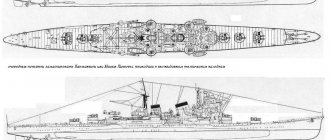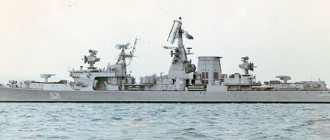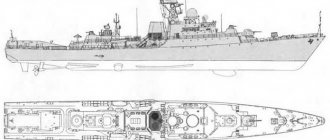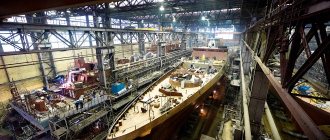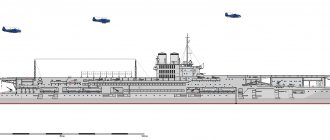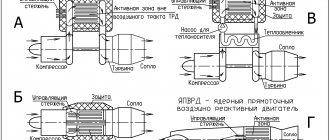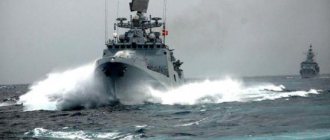Project 35 patrol ships
Project 35 patrol ships - 18 units.
They were created on the basis of the Project 159 SKR. They were distinguished by a more powerful power plant and an original hydraulic turbine propulsion unit (similar to that used on the Project 204 MPK). In terms of architecture and layout, they were an enlarged Project 204 MPK with weapons identical to the Project 159A ships.
SKR-39 (until May 19, 1966 – PLC-39, serial number 170). On May 26, 1961, she was laid down on the slipway of Shipyard No. 820 in Kaliningrad and on May 31, 1962, she was included in the list of Navy ships, launched on June 23, 1962, entered service on December 16, 1964, and on January 22, 1965, was included in the DKBF. Until May 19, 1966 it belonged to the PLC subclass. On October 1, 1974, it was withdrawn from service, mothballed and first in Baltiysk and on January 30, 1985 in Liepaja it was laid up. On April 19, 1990, it was expelled from the Navy in connection with its surrender to the OFI for disarmament, dismantling and sale, and disbanded on October 1, 1990. In 1991, it sank during the dismantling of mechanisms and systems at the Liepaja military port at the berth due to a malfunction of the bottom-outboard fittings. Subsequently, the UPASR of the Russian Navy was raised and handed over to a Latvian company for cutting into metal.
SKR-20 (until May 19, 1966 – PLC-20, serial number 168). 26.1.1961 was laid down on the slipway of Shipyard No. 820 in Kaliningrad, launched on 23.3.1962 and 31.5.1962 included in the lists of Navy ships, entered service on 25.12.1964 and 22.1.1965 included in the DKBF. Until May 19, 1966 it belonged to the PLC class. 10 – 15.8.1976 visited Copenhagen (Denmark). 4.5.1989 expelled from the Navy due to delivery to the OFI for disarmament, dismantling and sale. Disbanded on October 1, 1989.
SKR-7 (until May 19, 1966 – PLC-7, serial number 164). In January 1961, it was laid down on the slipway of Shipyard No. 820 in Kaliningrad and on July 1, 1961, it was included in the lists of Navy ships, launched on December 25, 1961, entered into service on December 29, 1964, and included in the DKBF on January 22, 1965. Until May 19, 1966 it belonged to the PLC class. 1-6.9.1978 paid a visit to Copenhagen (Denmark). On August 1, 1987, it was expelled from the Navy in connection with its delivery to the OFI for disarmament, dismantling and sale; on October 1, 1987, it was disbanded and in 1988–1989, at the Glavvtorchermet base in Baltiysk, it was cut into metal.
SKR-32 (until May 19, 1966 – PLC-32, serial number 169). On March 21, 1961, she was laid down on the slipway of Shipyard No. 820 in Kaliningrad, launched on May 15, 1962, and on May 31, 1962, she was added to the list of Navy ships. Until May 19, 1966 it belonged to the PLC class. Entered service on December 29, 1964 and was included in the DKBF on January 22, 1965. Until May 19, 1966 it belonged to the PLC subclass. 4.5.1989 expelled from the Navy due to delivery to the OFI for disarmament, dismantling and sale, 1.12.1989 disbanded and in 1990 sold to a Swedish company for cutting into metal.
SKR-86 (until May 19, 1966 – PLC-44, serial number 171). 10.8.1961 was laid down on the slipway of Shipyard No. 820 in Kaliningrad and on 28.8.1962 was included in the list of Navy ships, launched on 31.8.1962, entered service on 31.12.1964 and on 22.1.1965 included in the DKBF. Until May 19, 1966 it belonged to the PLC subclass. 24 – 29.6.1974 visited Turku (Finland) and 20 – 24.7.1978 – to Gdynia (Poland). 19.4.1990 expelled from the Navy due to delivery to the OFI for disarmament, dismantling and sale. Disbanded on October 1, 1990. In 1991, it sank during the dismantling of mechanisms and systems in the Baltic port at the berth due to a malfunction of the bottom-outboard fittings.
SKR-49 (until May 19, 1966 – PLC-49), from August 2, 1968 – “Ivan Sladkov” (plant No. 172). On October 17, 1961, she was laid down on the slipway of Shipyard No. 820 in Kaliningrad, launched on June 15, 1962, and on February 9, 1963, she was added to the list of Navy ships, entered service on June 25, 1965, and was included in the DKBF on July 15, 1965. Until May 19, 1966 it belonged to the PLC subclass. 5 – 10.6.1974 paid a visit to Gothenburg (Sweden). On October 1, 1974, it was withdrawn from service, mothballed and first in Baltiysk and on January 30, 1985 in Liepaja it was put into storage, and on April 19, 1990 it was expelled from the Navy in connection with its delivery to the OFI for disarmament, dismantling and sale. Disbanded on October 1, 1990. In 1991, it sank during the dismantling of mechanisms and systems in the Baltic port at the berth due to a malfunction of the bottom-outboard fittings.
SKR-53 (until May 19, 1966 – PLC-53, serial number 174). 11/30/1961 was laid down on the slipway of Shipyard No. 820 in Kaliningrad, launched on 12/10/1962 and on 2/9/1963 included in the lists of Navy ships, entered service on 8/31/1965, 9/29/1965 was included in the KChF and soon made an inter-naval transition around Europe from Baltiysk to Sevastopol. Until May 19, 1966 it belonged to the PLC subclass. From 12/17/1982 to 8/12/1983 at Sevmorzavod named after. S. Ordzhonikidze in Sevastopol underwent a medium renovation. 19.4.1990 expelled from the Navy due to delivery to the OFI for disarmament, dismantling and sale. 10/1/1990 disbanded and in 1991 cut up for metal in Sevastopol.
SKR-24 (until May 19, 1966 – PLC-8, serial number 175). 14.3.1962 was laid down on the slipway of Shipyard No. 820 in Kaliningrad, launched on 10.2.1963 and 12.8.1964 included in the lists of Navy ships, entered service on 30.9.1965 and on 2.11.1965 included in the DKBF. Until May 19, 1966 it belonged to the PLC subclass. 5 – 10.6.1974 paid a visit to Gothenburg (Sweden). 10/1/1974 withdrawn from service, mothballed and first in Baltiysk and 30/1/1985 in Liepaja laid up. 19/4/1990 expelled from the Navy in connection with delivery to the OFI for disarmament, dismantling and sale. Disbanded on October 1, 1990. In 1991, it sank during the dismantling of mechanisms and systems at the Liepaja military port at the berth due to a malfunction of the bottom-outboard fittings. Subsequently, the UPASR of the Russian Navy was raised and handed over to a Latvian company for cutting into metal.
SKR-83 (until May 19, 1966 – PLC-55), from June 9, 1980 – “60 years of the Komsomol of Belarus” (plant number 181). On July 20, 1963, it was laid down on the slipway of Shipyard No. 820 in Kaliningrad, launched on December 10, 1963, and on May 21, 1965, it was added to the list of Navy ships, it entered service on September 3, 1966, and on October 17, 1966 it was included in the DKBF. Until May 19, 1966 it belonged to the PLC subclass. On October 28-29, 1967, he visited Rostock (GDR) and on July 20-24, 1978, he visited Gdynia (Poland). From 6.1 to 7.3.1975, the Yantar Shipyard in the Baltic Shipyard in Kaliningrad underwent a medium overhaul. 24.6.1991 expelled from the Navy due to delivery to the OFI for disarmament, dismantling and sale. Disbanded on October 1, 1991. In 1992, it sank during the dismantling of mechanisms and systems in the Baltic port at the berth due to a malfunction of the bottom-outboard fittings.
SKR-84 (until May 19, 1966 – PLC-51, serial number 176). 17.5.1962 was laid down on the slipway of Shipyard No. 820 in Kaliningrad, launched on 10.4.1963 and 27.1.1965 included in the lists of Navy ships, entered service on 29.12.1965 and 25.1.1966 included in the DKBF. Until May 19, 1966 it belonged to the PLC subclass. In the summer of 1966, he made an inter-naval transition around Europe from Baltiysk to Sevastopol and on August 31, 1966 he was transferred to the KChF. From 2.2.1978 to 12.4.1979 at Sevmorzavod named after. S. Ordzhonikidze in Sevastopol and from 12/17/1985 to 5/5/1989 at the Fleet Arsenal shipyard in Varna (Bulgaria) there was a medium repair. 07/03/1992 expelled from the Navy due to delivery to the OFI for disarmament, dismantling and sale. 12/31/1992 disbanded and later cut up for metal in Sevastopol.
SKR-48 (until May 19, 1966 – PLC-48, serial number 177). 28.6.1962 was laid down on the slipway of Shipyard No. 820 in Kaliningrad, launched on 21.6.1963 and 27.1.1965 included in the lists of Navy ships, entered service on 31.12.1965 and 25.1.1966 included in the DKBF. Until May 19, 1966 it belonged to the PLC subclass. In the summer of 1966, he made an inter-naval transition around Europe from Baltiysk to Sevastopol and on August 31, 1966 he was transferred to the KChF. 10/1/1969 – 31/1/1970, while on combat duty in the war zone on the Mediterranean Sea, he carried out the task of providing assistance to the armed forces of Egypt. From January 31, 1975 to January 30, 1978 and from January 17, 1984 to May 22, 1986 at Sevmorzavod named after. S. Ordzhonikidze in Sevastopol underwent major and medium repairs. 26 – 30.5.1982 visited the port of Tunis (Tunisia). 19.4.1990 expelled from the Navy due to delivery to the OFI for disarmament, dismantling and sale. 1.8.1990 disbanded and cut into metal in Sevastopol.
SKR-12 (until May 19, 1966 – PLC-12, serial number 178). 12.9.1962 was laid down on the slipway of Shipyard No. 820 in Kaliningrad, launched on 18.5.1963 and 21.5.1965 included in the lists of Navy ships, entered service on 30.5.1966 and 16.6.1966 included in the DKBF. Until May 19, 1966 it belonged to the PLC subclass. 29.7 – 2.8.1969 paid a visit to Helsinki and 24-29.6.1974 – to Turku (Finland). From April 6, 1973 to October 25, 1974, a medium repair was carried out at the KMOLZ in Kronstadt. On October 1, 1989, it was withdrawn from service, mothballed and laid up in Liepaja. 10/1/1992 expelled from the Navy due to delivery to the OFI for disarmament, dismantling and sale. On December 31, 1992 it was disbanded, but on June 1, 1994, during the withdrawal of Russian troops from the territory of Latvia, it was left in a semi-submerged state at the berth in the port of Liepaja. Later cut into metal by a Latvian company.
SKR-19 (until May 19, 1966 – PLC-19, serial number 179). 25.2.1963 was laid down on the slipway of Shipyard No. 820 in Kaliningrad, launched on 27.7.1964 and 21.5.1965 included in the lists of Navy ships, entered service on 30.6.1966 and 29.7.1966 included in the DKBF. Until May 19, 1966 it belonged to the PLC subclass. 1 – 6.9.1978 visited Copenhagen (Denmark). From April 24, 1974 to April 7, 1976, a major overhaul was carried out at the Yantar Shipyard in Kaliningrad. 10/29/1992 expelled from the Navy due to delivery to the OFI for disarmament, dismantling and sale. Disbanded on 12/31/1992.
SKR-35 (until May 19, 1966 – PLC-35), from July 25, 1967 – “Gangutets” (plant No. 180). 12/19/1962 was laid down on the slipway of Shipyard No. 820 in Kaliningrad, launched on 9/27/1963 and on 5/21/1965 included in the list of Navy ships, entered service on 8/30/1966 and included in the DKBF on 9/9/1966. Until May 19, 1966 it belonged to the PLC subclass. On October 28-29, 1967, he visited Rostock (GDR). 19.4.1990 was expelled from the Navy in connection with delivery to the OFI for disarmament, dismantling and sale and 1.10.1990 was disbanded, but at the end of 1990 it sank during the dismantling of mechanisms and systems in the Baltic port at the berth due to a malfunction of the bottom-outboard fittings .
SKR-6 (until May 19, 1966 – PLC-6, serial number 182). 10.4.1963 was laid down on the slipway of Shipyard No. 820 in Kaliningrad, launched on 6.2.1964 and 12.3.1966 included in the lists of Navy ships, entered service on 30.11.1966 and 12.12.1966 included in the DKBF. Until May 19, 1966 it belonged to the PLC subclass. On July 28, 1967, he was transferred to the KChF and in the summer of 1967 he made an inter-naval transition around Scandinavia from Baltiysk to Sevastopol. 1 – 31.6.1967 and 1.1 – 31.12.1968, while on combat duty in the war zone in the Mediterranean Sea, carried out the task of providing assistance to the armed forces of Egypt. From 19.7.1976 to 2.3.1978 and from 23.1.1984 to 8.4.1986 at Sevmorzavod named after. S. Ordzhonikidze in Sevastopol underwent major repairs. 19.4.1990 expelled from the Navy due to delivery to the OFI for disarmament, dismantling and sale. 1.8.1990 disbanded and later cut into metal in Sevastopol.
SKR-13 (until May 19, 1966 – PLC-13, serial number 183). On May 31, 1963, it was laid down on the slipway of Shipyard No. 820 in Kaliningrad, launched on October 13, 1964, and on March 12, 1966, it was included in the list of Navy ships, it entered service on December 28, 1966, and on January 7, 1967, it was included in the DKBF. Until May 19, 1966 it belonged to the PLC subclass. On July 28, 1967, it was transferred to the KChF. 1 -31.6.1967 and 1.10.1969 - 31.1.1970, while on combat duty in the war zone in the Mediterranean Sea, carried out the task of providing assistance to the armed forces of Egypt. In the period from 7.2.1977 to 21.9.1978 and from 17.12.1982 to 9.4.1984 at Sevmorzavod named after. S. Ordzhonikidze in Sevastopol underwent medium and major repairs. 24.6.1991 expelled from the Navy due to delivery to the OFI for disarmament, dismantling and sale. 10/1/1991 disbanded and later cut up for metal in Sevastopol.
SKR-90 (production number 184). 10.2.1964 laid down on the slipway of Shipyard No. 820 in Kaliningrad, launched on 30.11.1964 and 24.8.1966 included in the lists of Navy ships, entered service on 30.5.1967 and 10.7.1967 included in the DKBF. From 31.7.1978 to 12.4.1979, the Yantar Shipyard underwent a medium repair at the Baltic Shipyard. 19.4.1990 expelled from the Navy due to delivery to the OFI for disarmament, dismantling and sale. Disbanded on October 1, 1990.
SKR-117 (production number 185). 10/15/1963 laid down on the slipway of Shipyard No. 820 (Baltic “Yantar”) in Kaliningrad, launched 25/2/1965 and 12/1/1967 included in the lists of Navy ships, entered service 29/6/1967, 29/7/1967 included in the KChF and in the summer 1967 made an inter-fleet transition around Europe from Baltiysk to Sevastopol. 1 – 31.6.1967, 1.8 – 31.12.1968 and 1.10.1969-31.1.1970, while on combat duty in the war zone in the Mediterranean Sea, carried out the task of providing assistance to the armed forces of Egypt. 9 – 12.8.1969 paid a visit to Varna (Bulgaria). From 5.2.1974 to 7.2.1977 at Sevmorzavod named after. S. Ordzhonikidze in Sevastopol and from 14.8.1980 to 24.8.1981 at the shipyard in Kerch, a medium repair took place. 19.4.1990 expelled from the Navy due to delivery to the OFI for disarmament, dismantling and sale. 10/1/1990 disbanded and later cut into metal in Sevastopol.
Total displacement – 1140 t normal – 960 t length – 82.4 m width – 9.1 m draft – 3 m (with sonar fairing – 5.84 m) Gas turbine power – 2×18000 hp diesels – 2×6000 hp full speed – 32 knots. (under turbines) and 20 knots. (under diesel engines), economic - 14 knots. cruising range - 2000 miles. Armament: 2x2 76-mm AU AK-726, 2x5 400-mm TA, 2x12 RBU-6000 (120 RGB-60) Crew - 96 people.
“The Americans showed courage by admitting mistakes in the F-35 project”
The first damn thing is lumpy
In November 2022, a Royal Navy F-35 sank in the Mediterranean Sea. The pilot managed to eject and was taken to the British aircraft carrier Queen Elizabeth. According to the findings of the British commission of inquiry, which were published on January 16, the cause of the accident was that a plastic raincoat from one of the military crew members got into the air intake of the plane. The serviceman's raincoat had previously been torn off by strong winds while preparing for takeoff.
“They gave the order in a couple of hours: “Hello, Alma-Ata!”
Colonel General Georgy Shpak commanded the Russian Airborne Forces from September 1996 to September...
January 18 11:28
In early January, a pilot from South Korea landed an F-35 on the fuselage because all the landing gear on the fighter did not come out at once. Seoul has suspended flights of all existing F-35s until the reasons that triggered the emergency are clarified.
The other day, several Chinese media outlets published photographs of American F-35C carrier-based fighter jets with traces of corrosion. It is not reported when or where these photographs were taken, but in the photographs, according to the authors, the planes of one of the US Navy aircraft carriers. Rusty stains are visible on their fuselages.
In March last year, the American publication Forbes reported that after 20 years of development of the F-35, the leadership of the US Air Force admitted that the aircraft was too expensive and unreliable for service. “The F-35 remains, for all intents and purposes, nothing more than an expensive prototype put into mass production,” Dan Grazer, a government surveillance project official, was quoted as saying by the publication, based on the latest DoD report.
“The Americans showed courage by admitting mistakes in the F-35 project when it became a mass-produced aircraft. In their justification, we can say that the F-35 was the first attempt to create a mass-produced fifth-generation fighter. This is their main advantage, and the first pancake is always lumpy,” retired Air Force Major General, former head of the Federal Aerospace Search and Rescue Directorate under the Ministry of Defense Vladimir Popov told Gazeta.Ru.
He noted that the United States was the first to implement mass radar signature reduction technology on these aircraft. “Purely technologically and operationally-tactically, the F-35 was planned and created as an invisible aircraft. This is also a new direction in the technological construction of modern combat aircraft,” Popov said.
According to him, the United States is positioning the F-35 primarily as an invisible aircraft. They put its combat capabilities in second place and maneuverability only in third place. “This is different from the Russian requirements for a fifth-generation aircraft - in it we put a high degree of maneuverability in first place, combat potential in second place, and low radar signature only in third place. At the same time, Russian fourth-generation fighters Su-27 and MiG-29 turned out to be comparable to fifth-generation US aircraft F-22 and F-35,” the expert said.
According to Popov, the biggest problem with the F-35 is that it turned out to be the most expensive aircraft in the history of fighter aviation.
According to calculations by the American publication The Fiscal Times, the total cost of creating and maintaining each F-35 for the entire planned operational period will be $670 million. “That’s why a trail of negativity followed this aircraft. Not because it technically does not meet the requirements of a fifth-generation aircraft, but for the reason that its incredible high cost suppressed the initiative for its widespread use,”
- said Popov.
At the same time, according to Alexander Ermakov, an expert at the Russian International Affairs Council (RIAC), the F-35 turned out to be what the American military demanded - a medium strike vehicle, largely focused on the era of local wars that the United States waged in 1990-2000 -s years. The expert notes that the F-35 fighter, according to the current development plan of the US Air Force, is considered a “workhorse” - the main machine.
“The F-35 is exporting quite successfully; now 10 countries are buying it. Recently, the United States entered into a contract for its supply with Switzerland and Finland - exports are growing. At the moment, more than 730 aircraft have been delivered to the US Air Force and for export; an unsuccessful aircraft would not have been produced in such quantities. The F-35 is not as successful as the Americans themselves would ideally like, but it would be good for Russia to bring its aircraft to this point,” Ermakov said.
Fastidious aircraft for hangars
According to the editor of Arsenal of the Fatherland magazine, military expert Alexei Leonkov, the F-35 will not go out of export. “Many countries that are involved in the F-35 program understand that they have been dragged into an adventure. But the F-35 will not go away from export, because it is a very good commercial project, which the Americans are promoting in European countries and selling to Australia and Japan,” Leonkov said.
Against drones and hidden targets. New anti-aircraft guns are entering the Russian army
The Russian Army will use the 2S38 self-propelled anti-aircraft gun to destroy drones...
17 January 20:24
According to Ermakov, the negative reputation of the F-35 is mainly due to the rather open nature of the program. “The F-35 had long delays in production under the program, now a lot of it is being produced - more than 100 units a year,” Ermakov said.
Among the shortcomings of the F-35, Popov highlighted problems with its radar-absorbing coating, which makes the aircraft “invisible.”
“This coating of paint material turned out to be very sensitive to sunlight. The aircraft only requires hangar storage in dry and warm conditions. It is necessary to maintain the temperature regime - no higher than 20 degrees Celsius and no lower than 18 degrees Celsius.
If an airplane is exposed to the sun for days, its coating is destroyed within 3-4 months. If it is stored according to the rules - for 2-3 years. Changing the coating is very expensive - it needs to be washed off and reapplied, this is done under sterile conditions at certain temperatures. This also has a negative effect on its operational characteristics - the aircraft must be put in for repairs all the time,” Popov said.
Another negative point is that the F-35 uses an all-electric flight system. “During the test flights, the plane behaved capriciously, lost control and the pilots ejected,” the expert believes.
Not all is well in the F-35 with the oxygen supply system - it was proposed to equip these aircraft with compressors that would take air during flight, filter it and supply oxygen for the crew and the operation of fuel automation. “It was a new word in aviation. But it turned out that they did not calculate the volumes of oxygen required to ensure the safe functioning of the aircraft systems. However, last year the Americans announced that they had finally overcome this “disease,” Popov concluded.
1st rank warships will be built in the Far East
From Komsomolsk-on-Amur at the end of December 2022 - under the Christmas tree - unexpected news came about the planned construction of frigates for the Russian Navy at the Amur Shipyard.
State Television and Radio Broadcasting Company "Far Eastern" of the TV channel "Russia 1" released a news story about the everyday life of the Amur Shipyard. The emphasis in the material was on the ongoing modernization of production, improvement of technology, mention was made of corvettes and small missile ships being built for the Navy. In connection with the implementation of the state defense order, the plant is being re-equipped according to the federal target program. More than 4 billion rubles were spent on this. The goal is to speed up the process of building ships.
First Deputy General Director of PJSC ASZ Mikhail Borovsky said that the plant is preparing to build a series of six frigates. The press service of PJSC ASZ confirmed to a correspondent of the Internet resource www.vl.ru that the company actually expects to sign a contract for the construction of frigates. Apparently, we are talking about the “Admiral of the Fleet of the Soviet Union Gorshkov” type of project 22350, the creation of which has been successfully mastered by the St. Petersburg shipyard represented by Sudostroitelny.
At the same time, M. Borovsky emphasized that in order to fulfill this order, it is necessary to modernize the internal slipways of the plant, where corvettes are currently assembled. The Project 22350 frigate is twice as large as the Project 22380 Steregushchy-class corvette. However, no major changes to the design of dry construction docks will be required. According to information from the official website of PJSC "ASZ", already now these docks (of which there are 9 pieces) allow the assembly of ship hulls up to 200 m long and up to 19 m wide. Note: the length of the first four frigates of the mentioned project is 135 m, width - 16.4 m. The docks are equipped with crane equipment with a lifting capacity of up to 100 tons and are equipped with scaffolding and all types of energy supplies. A distinctive feature is that the slipways are located in closed heated slipways. This allows the entire construction cycle to be carried out year-round under normal temperature conditions. In 2006, an open slipway was designed and put into operation, allowing the formation of ship hulls up to 23 m wide. It may be necessary to reduce the number of orders for auxiliary vessels for the Navy and civilian vessels so as not to occupy slipways, but these are organizational issues. To transport ships, the plant has a floating dock with a lifting capacity of 10 thousand tons.
ASZ has set the pace of construction of each corvette 22380 (from laying down to delivery to the customer) to a five-year period. While Shipbuilding takes 7 years to complete (judging by the Mercury corvette), it takes 10 years to build one frigate. And recently there was a fire at the Severnaya Verf - the built corvette "Provorny" burned down at the quay wall. The current situation in the shipbuilding industry does not allow the Russian fleet to be updated to an acceptable level in the next 10 years, and this is pushing the Russian Ministry of Defense to load the NAS with frigates. That is, to disperse the production of 1st rank surface ships to replace retired Soviet-built ones (they don’t last forever). It is obvious that all six frigates that M. Borovsky mentioned will be part of the Pacific Fleet (Red Banner Pacific Fleet).
Let’s assume that the Ministry of Defense will place an order for frigates at the Near-Earth Fleet this year, they will be laid down in 2023-2028, each will be built in 7 years, then by 2035 we will receive at least 10 frigates - this is taking into account the four built for the Pacific Fleet. By that time, most likely, only the Project 1164 missile cruiser “Varyag” and the Project 1155(M) frigate “Admiral Vinogradov” will remain from the Soviet heritage at the Pacific Fleet (other BODs are unlikely to be modernized due to their age). But these “oldies” will have to be written off by 2040. Well, okay, because in addition to the frigates, the Pacific Fleet will include the modern Project 23900 Ivan Rogov UDC, at least 12 22380 corvettes (three are already in service), at least 6 22800 Karakurt MRKs (also with cruise missiles), as well as numerous submarines . There will be a noticeable strengthening of our fleet on the Far Eastern shores. At the same time, other Russian fleets (Northern, Black Sea, Baltic) will also be strengthened, since they will not divert their capacities to replenish the Pacific Fleet with surface pennants.
The story of “Vesti-Khabarovsk”:
